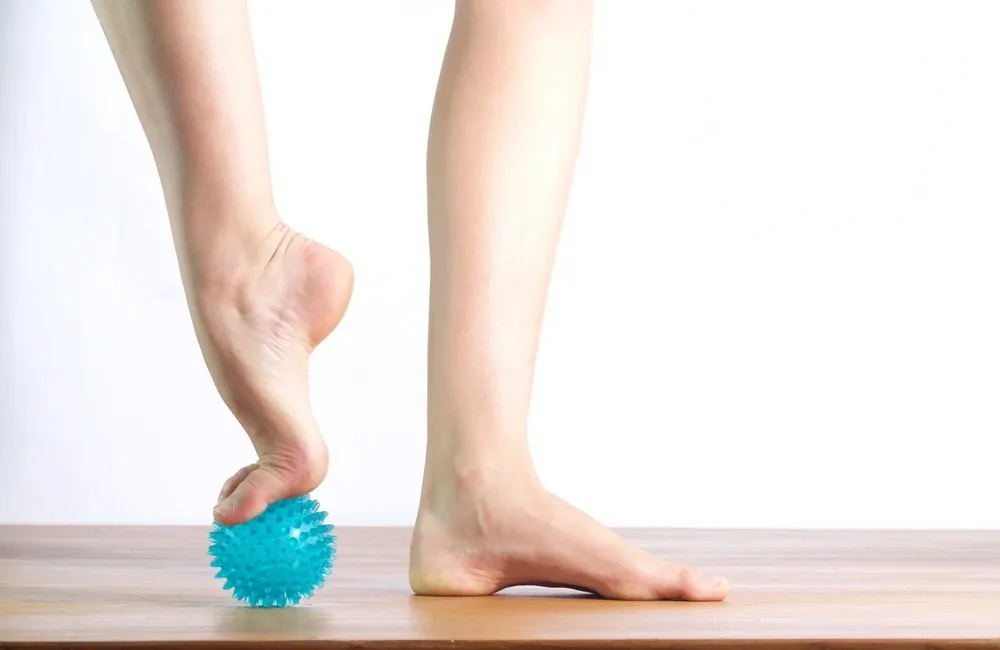Unlike the flat foot, which is intended to be supple and flattened, cavus foot is excessively arched and rigid. This foot problem is characterized by a pronounced curvature from the top of the secondary foot to the plantar arch that is very high.
It is also possible to observe a tightening between the heel and forefoot. This results in a curled appearance of the affected feet.
Cavus foot is not always a major source of pain as soon as it appears. However, if the deformity increases and the foot becomes more rigid, the arched foot can cause serious discomfort.
Symptoms and complications
Initially not very burdensome, advanced stage cavus foot can compromise the quality of life of individuals suffering from it.
In addition to causing pain in the plantar arch, hollow foot usually leads to the following symptoms:
- Plantar arch curvature more pronounced than normal
- Hump on the top of the foot corresponding to the excessive curvature
- Difficulty putting on shoes without any pain
- Cramps in the calves
- Stress in the plantar arch
- Joint pain in ankles, knees and hips
- Sensation of imbalance or unstable support during movement
- Repeated sprains
If cavus foot is not treated properly, it can result in the appearance of other painful foot disorders:
- Pain in the big toe: a problem that can eventually turn into a Hallux valgus-type deformity (bunion)
- Foot corns: the corn appears under heavily loaded contact points like toes or heels
- Plantar fasciitis
- Claw toe: excessive curvature or retraction of the toes in response to muscle imbalance
- Metatarsalgia
- Heel bursitis
- Postural problems: the tilting of the foot outwards causes other joints to shift out of balance, even reducing the natural curvature of the back.
Causes and aggravating factors
As is the case with flat foot, there are different categories of cavus foot: rigid, semi-rigid or flexible. But unlike this other plantar deformity, the development of cavus foot may be associated with neurological disorders.
Heredity therefore plays a major role in the development of this foot anomaly.
Certain medical conditions are also likely to contribute to an abnormal curvature of the plantar arch:
- Cerebral palsy
- Charcot-Marie-Tooth disease
- Spina bifida
- Parkinson’s disease
- Muscular dystrophy
- Stroke
- Multiple sclerosis
- Diabetes with neuropathic complications
In addition to genetic predispositions and medical conditions, other physical factors may be involved. This is referred to as acquired cavus foot.
While it occurs less frequently, acquired cavus foot is just as incapacitating and is not to be taken lightly.
Acquired hollow foot may be due to:
- Hypertrophy of function: professional deformation of the athlete who performs repetitive movements. Sprinters and ballet dancers are particularly vulnerable.
- Serious or improperly treated trauma: fracture or severe dislocation of the lower limbs without proper rehabilitation.
- Prolonged immobility: prolonged bed rest or immobilization with a cast in a precarious position without appropriate physiotherapy.
Prevent pain associated with cavus foot
Since cavus foot is mainly due to heredity, it is not always easy to know how to approach it. Nevertheless, it is possible to adopt certain preventive habits.
Here are some available steps to minimize the negative impacts of cavus foot on the health of your feet and your posture:
- Purchase supportive and balanced shoes: ideally, these shoes should have a light heel and a wide opening. This way you can put them on painlessly and comfortably.
- Establish a stretching routine: stretching helps to reduce plantar stiffness and can reduce tension in your Achilles tendons.
- Foot arch massage: foot arch massages help to reduce stiffness under the foot and mobilize the joints of the foot. A tennis ball is sufficient to perform this specific massage.
- Purchase prefabricated insoles: for early stage cavus foot, the addition of insoles to shoes contributes to better shock absorption.
Treatments for cavus foot
While the adoption of preventive measures is sufficient in some cases, cases of hollow foot are never to be taken lightly. To avoid joint and posture complications as much as possible, it is recommended to consult a podiatrist.
They are able to analyze the severity of the condition and recommend the most appropriate treatments:
- Foot care: safe treatment focused on removing painful corns on the feet that form in the heel and toes.
- Manual foot therapy: consists of gentle manipulations to promote flexibility of the hollow foot and mobilize sore joints.
- Plantar orthotics: proven to be effective, custom-made orthotics allow weight to be distributed evenly over the entire surface of the hollow foot. They improve stability, reduce the formation of corns and reduce stress on other joints.
As a last resort, if the pain and deformities are too significant, bone surgery may be recommended by the podiatrist.

